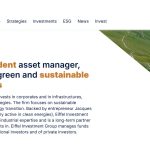ESGY Is Meeting Unique Demands of ESG Investors

Enthusiasm for environmental, social, and governance (ESG) funds is palpable. So are demands that exchange traded funds in this arena provide legitimate ESG exposure in simple form without greenwashing.
The American Century Sustainable Growth ETF (ESGY) is an example of an ETF that answers those calls. Put simply, companies residing in ESGY are those with clear sustainability goals and those working to enhance or exceed social and governance objectives. How the actively managed fund’s roster is constructed is relevant to investors at a time when ESG ratings and scoring are under the microscope.
ESGY “combines quantitative and fundamental research from multiple sources to ensure exposure to companies with more attractive ESG characteristics,” according to American Century. “Utilizes a dynamic risk-management process focused on understanding and quantifying all portfolio risks.”
Focusing on the environmental side of the ESG equation, ESGY is exceedingly relevant today because environmental goals are usually easy to define relative to the other parts of ESG, and the spending required to accomplish those objectives is massive, potentially positioning ESGY for long-term growth.
“A recent report estimated $69 trillion of negative economic impact directly related to global warming,” according to Fidelity research. “In our view, the steps to blunt the impact of climate change and successfully navigate its effects will be one of the single largest economic drivers of the next century. But we see both near- and long-term investment opportunity and portfolio risk mitigation potential as people, companies, and governments worldwide take action.”
To that end, ESGY featured no exposure to energy and utilities stocks and only scant exposure to the materials sector as of the end of 2021. Rather, about two-thirds of the fund is allocated to the technology and consumer discretionary sectors. That’s a slight overweight on a combined basis relative to the Russell 1000 Growth Index, which is the benchmark that ESGY attempts to beat.
Overall, ESGY is a solid idea for advisors and investors looking to demystify ESG principles while employing a growth-heavy approach to sustainability. Those characteristics could prove attractive over the long haul.
“But there’s plenty of room for misunderstanding, because sustainable investing, often called environmental, social, and governance investing, actually comprises a wide range of approaches,” writes Morningstar analyst Leslie Norton. “In some cases, ESG metrics are used primarily to help fund managers understand how much ESG risk a company face. Many actively managed funds, whether they are sustainability focused or traditional, also use ESG ratings to limit risk.”
Source: Nasdaq








